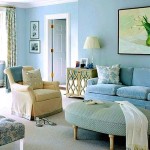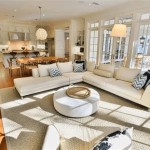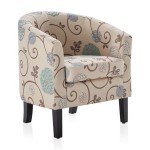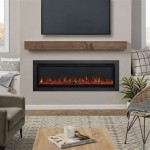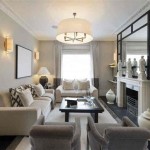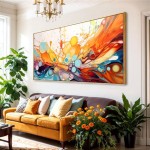Designer Ideas For Living Rooms
The living room serves as a central hub within a residence, functioning as a space for relaxation, entertainment, and social interaction. Designing a living room requires careful consideration of aesthetics, functionality, and personal preferences. A well-designed living room should be both visually appealing and practical, catering to the specific needs and lifestyle of its occupants. This article explores various designer ideas to enhance the living room, focusing on key elements such as space planning, color palettes, furniture selection, lighting, and decorative accents.
Optimizing Space and Layout
Effective space planning is paramount to creating a functional and aesthetically pleasing living room. This involves considering the room's dimensions, architectural features, and intended use. The arrangement of furniture should facilitate movement and interaction while maximizing available space. Prior to placing any furniture, it's important to measure the room and create a floor plan. This can be done using design software or simply with graph paper. The floor plan should take into account walkways, door swings, and windows, ensuring that the layout feels balanced and uncluttered.
One common challenge is accommodating a television. The placement of the television should be optimized for viewing distance and minimized glare. Consider mounting the television on the wall to save floor space or integrating it into a custom entertainment unit. Comfortable seating arrangements are essential. A sofa should be the focal point, complemented by armchairs, ottomans, or accent chairs. These pieces should be arranged to encourage conversation and create a sense of cohesiveness. Area rugs can define specific zones within the living room, such as a seating area or a reading nook. They should be appropriately sized for the space and coordinated with the overall color scheme.
For smaller living rooms, the key is to maximize space efficiency. Multi-functional furniture, such as a sofa bed or a coffee table with storage, can be invaluable. Mirrors can create the illusion of greater space by reflecting light and adding depth to the room. Vertical storage solutions, such as bookshelves or floating shelves, can utilize wall space effectively without occupying valuable floor area. A minimalist approach to decor is also recommended, avoiding clutter and unnecessary items that can make the room feel cramped.
In larger living rooms, the challenge is to create a sense of intimacy and cohesion. Dividing the room into distinct zones using furniture placement, rugs, or architectural features can help achieve this. For example, a large living room might include a reading area with a comfortable armchair and a floor lamp, a conversation area with a sofa and chairs, and an entertainment area with a television and media console. Strategic placement of decorative elements, such as artwork or plants, can further enhance the sense of warmth and visual interest.
Selecting Colors and Materials
The color palette of a living room significantly influences its overall ambiance and aesthetic. Colors can evoke different emotions and create a sense of warmth, tranquility, or vibrancy. When selecting colors, consider factors such as the room's natural light, the desired mood, and personal preferences. Neutral colors, such as white, beige, and gray, provide a versatile backdrop that can be easily complemented with accent colors. These neutrals create a sense of spaciousness and allow furniture and decorative elements to take center stage.
Accent colors can be introduced through paint, textiles, artwork, and accessories. Bold colors, such as blue, green, or yellow, can add vibrancy and personality to the room. These colors can be used sparingly to create focal points or more liberally to create a more dramatic effect. Consider the psychological effects of different colors. Blue is often associated with calmness and serenity, while green is associated with nature and harmony. Yellow is associated with energy and optimism, while red is associated with passion and excitement.
The choice of materials also plays a crucial role in the overall design of the living room. Natural materials, such as wood, stone, and leather, can add warmth, texture, and sophistication. Wood flooring or wood accents on furniture can create a sense of connection to nature. Stone fireplaces or stone walls can add a touch of rustic elegance. Leather upholstery can add a luxurious and timeless appeal. Textiles, such as velvet, linen, and cotton, can add softness and comfort to the room. Different textures can be combined to create visual interest and tactile richness.
Lighting design is an integral part of color and material selection. The color of light can significantly affect how colors and materials appear. Natural light should be maximized by keeping windows unobstructed and using light-colored window treatments. Artificial lighting should be layered to provide both ambient and task lighting. Ambient lighting provides general illumination, while task lighting provides focused light for specific activities, such as reading or working. Dimmable lighting is a valuable addition, allowing for adjustments to the light level to suit different moods and activities.
Furniture and Decorative Accents
Furniture selection is a critical aspect of living room design. The furniture should be both aesthetically pleasing and functional, providing comfortable seating and storage solutions. When selecting furniture, consider the size and shape of the room, as well as the overall style and color scheme. A sofa is typically the largest and most important piece of furniture in the living room. Choose a sofa that is comfortable, durable, and visually appealing. Consider the upholstery material, the frame construction, and the overall style of the sofa.
Accent chairs can complement the sofa and provide additional seating. These chairs can be used to add visual interest and personality to the room. Choose chairs that are comfortable and stylish, and that coordinate with the overall color scheme. Coffee tables provide a surface for drinks, snacks, and decorative items. Choose a coffee table that is appropriately sized for the space and that complements the other furniture in the room. Side tables provide additional surfaces for lamps, books, and other items. Choose side tables that are both functional and aesthetically pleasing.
Decorative accents can add personality and visual interest to the living room. Artwork, such as paintings, prints, and sculptures, can be used to create focal points and add color and texture to the room. Choose artwork that reflects personal taste and that complements the overall style of the room. Plants can add a touch of nature and freshness to the living room. Choose plants that are appropriate for the room's lighting conditions and that complement the overall style of the room. Throw pillows and blankets can add comfort and texture to the seating area. Choose pillows and blankets that are soft, comfortable, and visually appealing.
Lighting fixtures are both functional and decorative elements. Table lamps provide task lighting for reading and other activities. Floor lamps provide ambient lighting and can add height and visual interest to the room. Chandeliers and pendant lights can create a focal point and add elegance to the room. Rugs can define specific zones within the living room and add warmth and texture to the floor. Choose rugs that are appropriately sized for the space and that coordinate with the overall color scheme. Curtains and blinds can provide privacy and control the amount of light that enters the room. Choose curtains and blinds that are both functional and aesthetically pleasing.
Finally, personalizing the living room is essential to creating a space that feels comfortable and inviting. This can be achieved by incorporating personal items, such as family photos, souvenirs, and collections. These items can add a sense of history and personality to the room, making it feel more like a home. The key is to curate these items carefully and arrange them in a way that is both aesthetically pleasing and meaningful.

80 Gorgeous Living Room Decorating Ideas For Every Style
:strip_icc()/cdn.cliqueinc.com__cache__posts__212361__-2030968-1483470364.700x0c-8571e60cad7b42a981ab29ae10b5c153-497b002f87af4747b2ab38b560e7c0fd.jpg?strip=all)
Living Room Decorating 20 Ideas And Common Mistakes

80 Gorgeous Living Room Decorating Ideas For Every Style

How To Design The Perfect Living Room In 5 Easy Steps

Living Room Decor Ideas For Your Home Design Cafe

4 Need To Know Tips For Decorating A Small Space

7 Small Living Room Design Ideas Oppein

How To Decorate A Small Living Room Houzz

House Home 10 Living Room Design Ideas You Ll Love

Small Living Room Ideas Decorating

